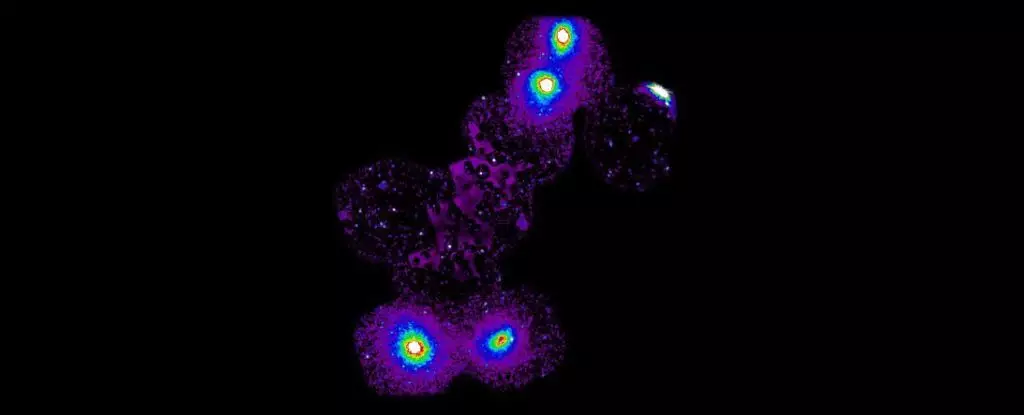In our relentless pursuit of understanding the Universe, one of the most perplexing enigmas lies in the revelation that roughly 85% of its matter remains enigmatic, cloaked in the shadows of what we term “dark matter.” For decades, astronomers and physicists have grappled with the ramifications of this hidden substance, which outstrips commonplace matter—comprising protons, neutrons, and electrons—by a startling margin. Recent discoveries, however, like the extraordinary filament of hot gas discovered in the Shapley Supercluster, offer tantalizing clues about this elusive cosmic fabric.
Shapley Supercluster: A Hotbed for Discovery
The Shapley Supercluster, an imposing assemblage of around 8,000 galaxies, serves as a significant focus for astrophysical studies. Recently, X-ray observations indicated a breathtaking filament of gas stretching an astonishing 23 million light-years, nestled among the sub-clusters of this cosmic colossus. Astrophysicist Konstantinos Migkas and his team have shed light on the longstanding discrepancies regarding matter distribution in the Universe. In their findings, they articulated a breakthrough aligning with leading cosmological models. This is profound, as it confirms theories previously relegated to simulations, thereby injecting fresh vigor into the ongoing dialogue about the Universe’s architecture.
The Dark Dance of Normal and Dark Matter
Our comprehension of matter in the Universe is often dissected into two distinct groups: normal and dark matter. The former, which constitutes a scant 15% of total matter, is what sustains stars, planets, and life as we know it. In contrast, dark matter remains a formidable obstacle in our understanding. The Cosmic Microwave Background radiation offers a snapshot of the early Universe, revealing the initial abundance of normal matter. Yet, the sheer scale of discrepancy between early estimations and current observations raises an irresistible question: where has all this matter disappeared?
The prevailing hypothesis suggests that the missing matter has settled into the vast expanses of intergalactic space, hungrily dispersed across the interstellar web. This proposition turns our gaze toward the cosmic web—a grand tapestry of dark and normal matter interwoven into filaments that crisscross the cosmos, often going unnoticed. It is here, in the shadows, that the newly uncovered filament serves as compelling evidence of the Universe’s complexity and the distribution of its material wealth.
Unraveling Cosmic Filaments: Techniques and Discoveries
The revelation of the giant filament owes itself to cutting-edge technology and sophisticated observational techniques. By leveraging two powerful X-ray telescopes, the team, led by Migkas, achieved the remarkable task of distinguishing a faint filament from the cosmic backdrop. The retired Suzaku X-ray telescope excels at detecting broader, fainter emissions over extensive areas, whereas XMM-Newton is adept at isolating bright point sources, carving out a niche for pinpointing cosmic mysteries. This dual approach allowed the researchers to filter out interference and focus on the subtle glow emanating from the newly discovered structure.
Stretching between the A3528S/N and A3530/32 galaxy clusters, the filament embodies the predicted characteristics described in theoretical frameworks, pulsating with a heat level exceeding 10 million degrees Celsius. This discovery does not merely serve as a confirmation of simulation predictions—it lays a robust foundation for the scientific method in cosmic measurement, revolutionizing our ability to uncover and analyze the Universe’s intricate webs.
A New Era of Cosmic Collaboration
The completed research signifies far more than a breakthrough in identifying astral structures; it exemplifies the importance of cooperation between diverse astronomical instruments in unraveling the Universe’s mysteries. As Norbert Schartel from the European Space Agency aptly remarked, the study sets a new benchmark for detecting the faint lights emanating from cosmic filaments. This collaboration underscores the inherent synergy between technology, theoretical models, and empirical observation, marking a turning point in how we understand the cosmos.
Through the intricacies of scientific inquiry and cosmic exploration, the discovery of this filament not only enriches our comprehension of matter distribution in the Universe but also rekindles hope of further revelations waiting in the cosmic wilderness. Each new finding nudges us closer to constructing a complete picture of the Universe, reiterating that even amidst great unknowns, we are always on the verge of uncovering groundbreaking insights that can reshape our understanding of existence itself.

